Turquoise Energy News #155
covering April
2021 (Posted May 5th 2021)
Lawnhill BC Canada - by Craig Carmichael
www.TurquoiseEnergy.com
= www.ElectricCaik.com
= www.ElectricHubcap.com
Month
In
"Brief"
(Project Summaries etc.)
- More Snow! ...then nice weather - Zinc Plating the C Cell -
Sodium Sulfate lead-acid Battery Life Extender - Toyota Echo Plug-in
Hybrid Conversion? - The Low Rolling Resistance Tires - Handheld
Bandsaw
Mill Kit - Solar PV: Cheapest Energy Ever - Supercorder Making
Instructions
In
Passing
(Miscellaneous topics, editorial comments & opinionated rants)
- Titan's Elliptical Orbit - Auroras of Ganymede - Small
Thots (CoViD again (sigh!) - Hair Loss Recovery) - ESD
- Detailed
Project Reports
-
Electric
Transport - Electric Hubcap Motor Systems
* Improved Configuration for a 100% Efficient Torque Converter
* Miles Electric Mini-Cargo Truck: Chargers?: Killer Battery
Dischargers! - Shaft balanced,
reinstalled
* Toyota Echo Plug-in Hybrid Conversion?
Other "Green"
Electric Equipment Projects
* Handheld Bandsaw Mill Kit
Electricity Generation
* My Solar Power System: -
Annual Summaries and Estimates (2 years) - Daily/Monthly
Solar Production log et cetera - Monthly Summaries and
Estimates (26 months)
Electricity Storage
* Turquoise Battery Project
(NiMnOx-Zn in Mixed Alkali-Salt electrolyte)
- Zinc Plating Onto Graphite Felt
It Snew - Again!

But on the 12th, after almost no sunshine all dreary
winter, it was suddenly
sunny, for most of the rest of the month with a small gap, and it
started warming up. As the days were
rapidly getting longer and the shadows shorter, about one day out of
two set a new daily record for 2021 of
solar electricity generated: 11, 12, 13, 14 KWH. (It never hit 14 in
April 2020!) Total for the month was virtually the same as April last
year, with a greater spread between 'least' and 'most'.
After I finished the final writeup of the last newsletter,
I spent a couple of days making a crossword puzzle for the May-June
issue of Haida Gwaii Trader magazine. And having someone test play it,
then fixing up a final version. AFAIK there's no good computer software
for creating crossword puzzles (but then I've never looked) and I make
them on a piece of graph paper. I then enter the blank and the answer
key
(rather laboriously) into HTML tables so they look nice, and do .PNG
screen grabs to send to the magazine. The clues are just text, but
that's the part that I need to conscript a neighbor for to test play it
and make sure it all works properly and see if any clues are too
indecipherable. I think this is the fifth one I've done. HaidaGwaiiTrader.com covers
many local topics and can be
read on line.
With the good weather I feel blessed to hear the
continuing chorus of frogs from a nearby small swamp, as well as
occasional flocks of gaggling geese going north overhead. It gives one
the sense that "all is well" with the world.
Zinc Plating the C Cell (at last!)
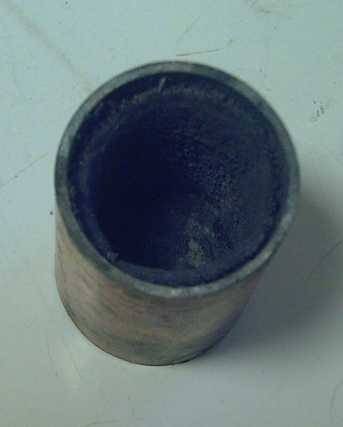 I
put some conductive graphite felt around the inside rim of the larger
"C" cell
and got about 3 grams of zinc plated into it, and surely enough onto
the cleaned copper can to make a solid zinc trail to conduct from the
felt to the copper can. So the cell is almost ready to assemble. I was
surprised how much the remaining diameter is reduced.
I
put some conductive graphite felt around the inside rim of the larger
"C" cell
and got about 3 grams of zinc plated into it, and surely enough onto
the cleaned copper can to make a solid zinc trail to conduct from the
felt to the copper can. So the cell is almost ready to assemble. I was
surprised how much the remaining diameter is reduced.
Then I got onto other things.
Thinking about it: if you have ten or a dozen projects,
either you set some aside month after month, or
you're lucky to be able to spend 2 days a month on each one. That'd be
20-24 days and various other
things always come up. I always spend some time writing, including
TE News. I've done just a little gardening, firewood collection,
construction and so on, but make my meals, shop, and I still look after
5 chickens who the raccoons want for late night snacks if I get
careless.
Miles Truck & Killer Battery
Dischargers
I went to add three more lithium iron phosphate batteries
to the Miles electric mini cargo truck and remove the remaining
lead-acids. But when I went in I found the ones already in the truck
were swollen up. It turned out that unsuspected by me, something was
rather heavily discharging them even with the truck turned off - enough
to drain the whole set of drive batteries seemingly in 2 or 3 weeks.
I'm pretty sure it was the "Delta-Q" battery charger. They were ruined!
They would not charge.
If you were using the truck regularly you wouldn't
notice, but being idle for some time it killed batteries. That also
explains why the original lead-acid 'golf cart' batteries had degraded
so badly over time for no apparent reason, too.
I also found another charger, likewise still connected to
a battery but unplugged from the wall, had almost discharged a lithium
battery in the Sprint car that I was taking for the truck. It took many
hours to recharge. If I had left that one too much longer, it would
doubtless have been ruined too.
It's hard to believe that companies selling supposedly
professional battery chargers obviously intended to remain connected to
the batteries would be so cavalier with customers' batteries when they
could easily put in protection diodes so that the chargers wouldn't
gradually discharge them when not plugged into the wall. ...And not
even mention it to the customers! Replacing those batteries with new
ones would be around 1800$C. Being used, I was selling them for 250$,
and now I'm sorry I was because I only have 5 out of the 6 needed for
the truck. I had to change the plan.
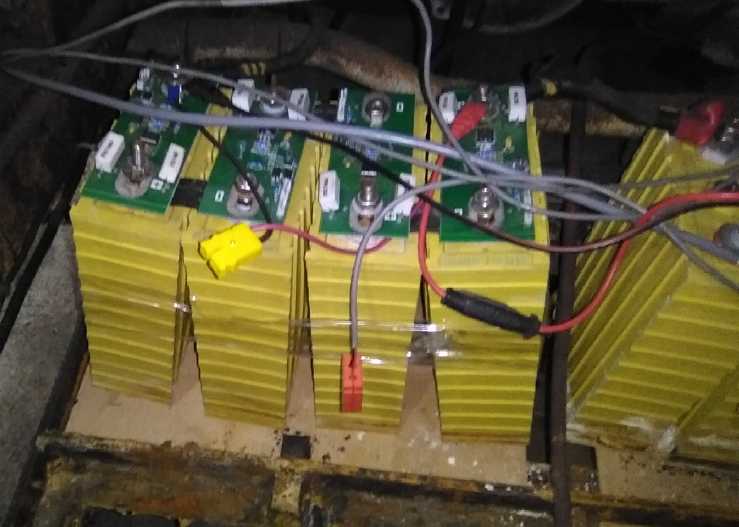 Three Ruined 12V batteries; twelve 100 AH
lithium iron phosphate cells.
Three Ruined 12V batteries; twelve 100 AH
lithium iron phosphate cells.
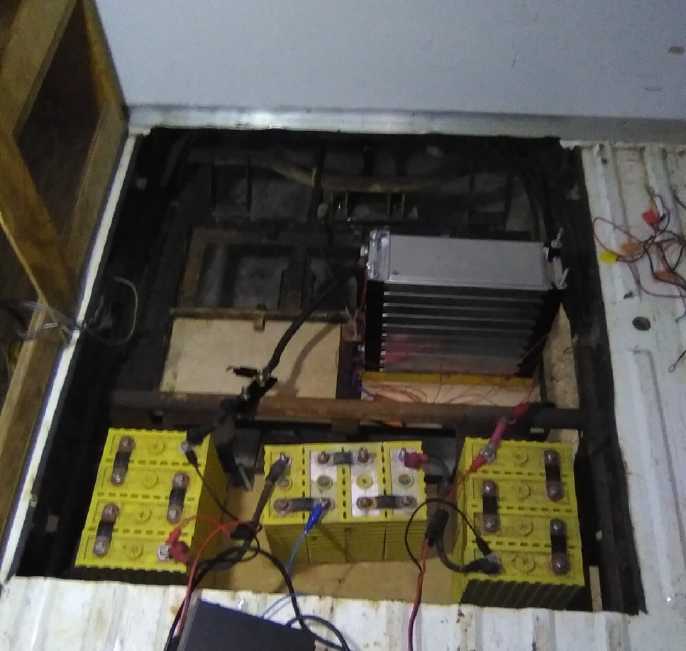 The new set: three of the five remaining yellow
lithium iron phosphate batteries (100 AH, 36V)
The new set: three of the five remaining yellow
lithium iron phosphate batteries (100 AH, 36V)
and one of the new stacks of ten lithium ion batteries (120 AH, 36V -
later bolted down).
So the truck gets 100 AH (if that - the middle yellow one is well used)
at its required 72 volts.
One observes that they occupy much less than 1/2 the space of the 12
golf cart batteries,
and their weight is about 132 pounds instead of 840 - a reduction of
about 710 pounds.
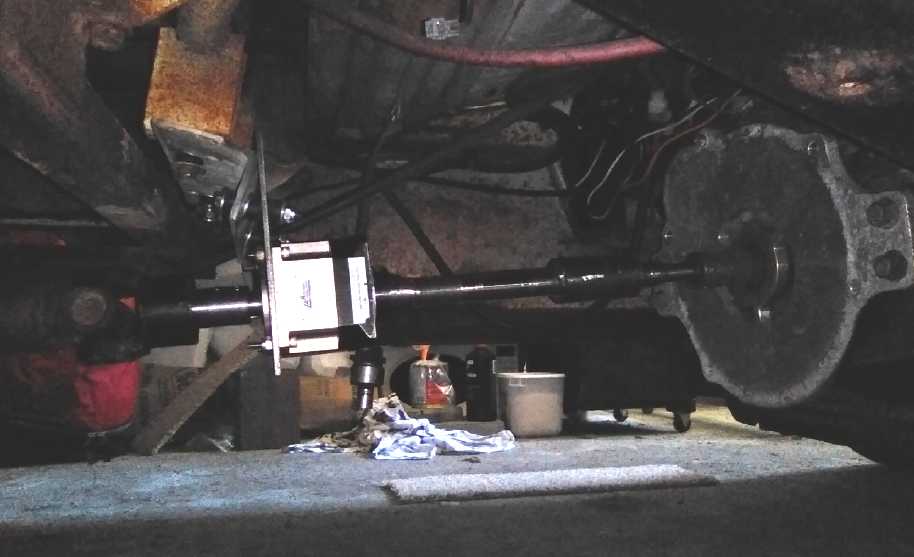 Back on the actual project... I reinstalled the
balanced, welded drive shaft from the Curtis AC35 motor (right)
Back on the actual project... I reinstalled the
balanced, welded drive shaft from the Curtis AC35 motor (right)
to the 5:1 planetary gearset (shiny box) under the truck. The front of
the drive
shaft (black) to the rear wheels with its "U joint" can be seen at the
left.
(Now, about all that clutter by the garage far wall...)
Sodium Sulfate Lead-Acid Battery Life
Extender & Toyota Echo
I bought 3 months insurance for the Toyota Echo (gasoline
car)
as I would soon have to drive to Masset and pick up my nuc (nucleus
hive) of Carniolan bees. (There's nothing much available in BC between
a
"day
pass" and 3 months car insurance.) On the 17th I
couldn't get it to start. In this car too, something drains the battery
slowly but continually. I'd disconnect it when the car isn't
licensed/used except
the heavily corroded terminals with rusty bolts were a great
disincentive to wanting to touch it. It's happened before, but this
time charging it, even overnight, didn't seem to help. The
charger claimed it was charged, but the engine would barely turn over.
Twisting the battery terminals around to get a better connection didn't
help. Adding
distilled water didn't help - the level wasn't down too far anyway.
(I'm glad I didn't wait for the day I needed it to try starting the
car!)
I thought, hey!, I've never put sodium sulfate in this
battery - never
had the caps off it before. So I funneled a tablespoon of it into each
cell. Then I turned on the headlights to start cycling the battery. Was
it 3+ discharges and then recharges? It's been a long time since I was
doing this.
(And when I was into investigating PbPb battery
renewal some years ago, it was a fiasco... In acid (pH 1) the reaction
voltage of PbO2
=> PbSO4 is +1.7V. Owing to a wrong figure on a chart that said PbO2
=>
PbSO4 was +2.5V instead of +0.5V at neutral/alkaline pH, I was totally
confused for a couple of years as to why the voltage would drop instead
of either rise or else completely cease to work if I added enough
sodium sulfate to raise the pH. I thought
cells must be going bad inside the batteries to explain the lowered
voltages. Being
unable to measure individual cells and figure out what was going on,
the confusion was a
big waste of time and a whole pile of doubtless perfectly useful
batteries! If the pH rose, they needed a charger that would stop at
(eg) 11.5 volts
instead of frying it by trying to drag it up to 13+.
All because of a simple typo or
copying error in a book on the most critical number, one I didn't find
shown elsewhere correctly for a long, long time! Moral: Don't
believe
everything you read?)
Back to the story... I drew it down for well over an hour until the
voltage
dropped under 11.5V. I figured that was far enough and put it back on
slow charge with the best restorative high-frequency "miracle" slow
rate pulse charger. The car engine would still
hardly turn over. Then I did a second draw-down to 11.5V with the
lights, and another recharge. No better. The next morning, I went down
to 11.3V and back up again.
But it was no dice on starting the car. Finally I bought
another battery. That didn't help either. What was going on?
I tried to start the Echo by letting out the clutch in 3rd
gear
while it was rolling down a small hill on my back drive. But it was
almost like
putting on the brakes! There were squealing noises. No way the car
would start. So! It wasn't the battery or the starter: the engine
wasn't seized, but it really didn't want to turn!
I loosened the alternator (breaking the head off the
seized
adjustment bolt to get it loose!) and discovered the alternator was
seized. With the belt off, the car started easily.
I got the alternator off. The housing was cracked and
bulging out. Probably from corrosion. That settled any idea of trying
to repair it. I put the old battery back in and (after making sure it
started the car) drove to the auto parts store. They took the battery
back (yay! 150$!), but the alternator was about 335$. I put it in
and went for a test drive. Everything seemed fine.
The 2014 battery, drained to nothing several times and now
"restored" with the sodium sulfate and pulse charging, still starts the
car no problem, time after time. Next time I'm going to leave the car
sit for months, I'll disconnect it.
Toyota Echo Plug-in Hybrid Conversion?
I started thinking again about the idea of turning the
Echo into a plug-in hybrid with an electric drive on the right rear
wheel. It's a good car. In some ways I like it better than the Nissan
Leaf. I'm short of EV batteries now, but if I could make it work - and
work
well including on the highway - I could sell the Leaf and have a lot of
money for more batteries!
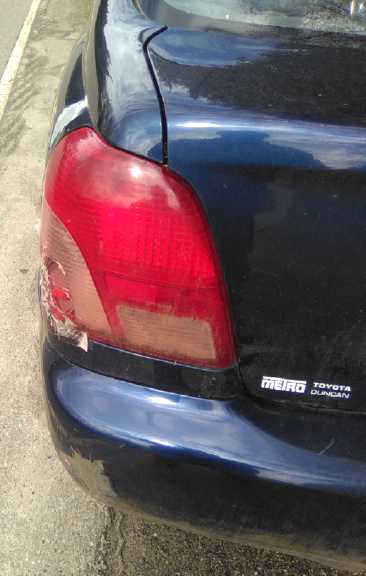 Then I started thinking about all the little things it needed if it was
to become a "nice" project car. What about the cracked windshield? And
the broken tail light? And the non-functional parking brake (ever since
I changed rear brake shoes)? And then how about that intermittent and
noisy cab air fan? And the dash lights that only work sometimes? And
the much pitted, fogged-up plastic headlights? It could use some
cleanup and a vacuuming, too! With 420 Mm* on it, it could hardly be
expected to be like new. I dealt with a few of these things, and they
occupied several days of the month.
Then I started thinking about all the little things it needed if it was
to become a "nice" project car. What about the cracked windshield? And
the broken tail light? And the non-functional parking brake (ever since
I changed rear brake shoes)? And then how about that intermittent and
noisy cab air fan? And the dash lights that only work sometimes? And
the much pitted, fogged-up plastic headlights? It could use some
cleanup and a vacuuming, too! With 420 Mm* on it, it could hardly be
expected to be like new. I dealt with a few of these things, and they
occupied several days of the month.
* That's "Megameters" for all those who don't know the
scalable metric system quite as well as they thought they did.
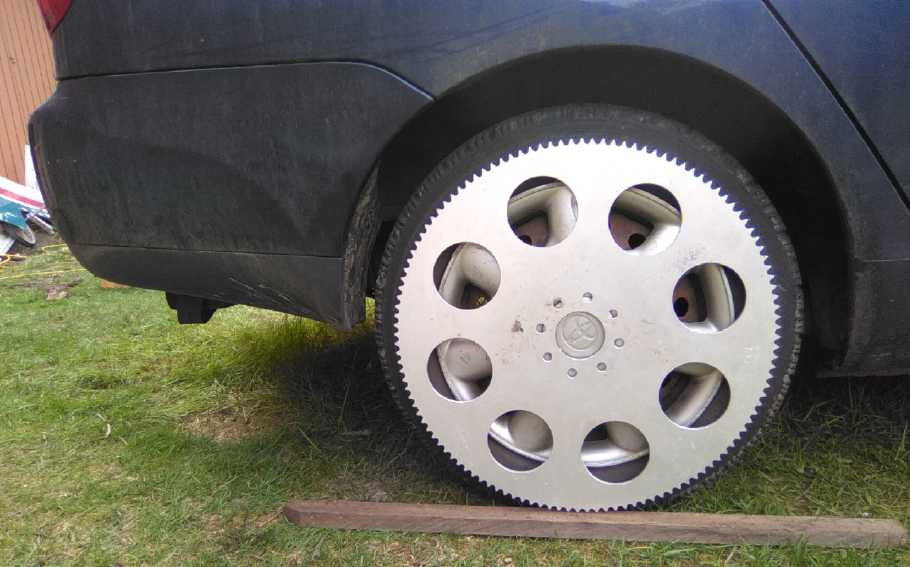
I dug out the 120 tooth, #40 chain sprocket that would fit
on the rear wheel, and a 20 tooth one that would give it 6
to 1 reduction. Then I pulled out the stiff, formed upholstery
obscuring the right
wall of the trunk, and began to think that if I simply mounted a motor
in the trunk and put a really heavy spring on it to tension the chain,
it could propel the car. It would need one large hole through the sheet
metal
and the plastic bumper for the shaft with the sprocket on it.
The only motor I'd want to try this with at this time
(without making the long planned unipolar BLDC and a controller for it)
is probably the 36 volt forklift motor, for which I already have the
motor controller. Wait, that motor was for the Sprint! It looks like I
have to pick one project or the other.
I got out the motor, got the other half of the lovejoy
connector out of the original Sprint transmission, and rounded up a few
more potential parts. The idea is simple; exactly how to actually do
everything is going to get complicated.
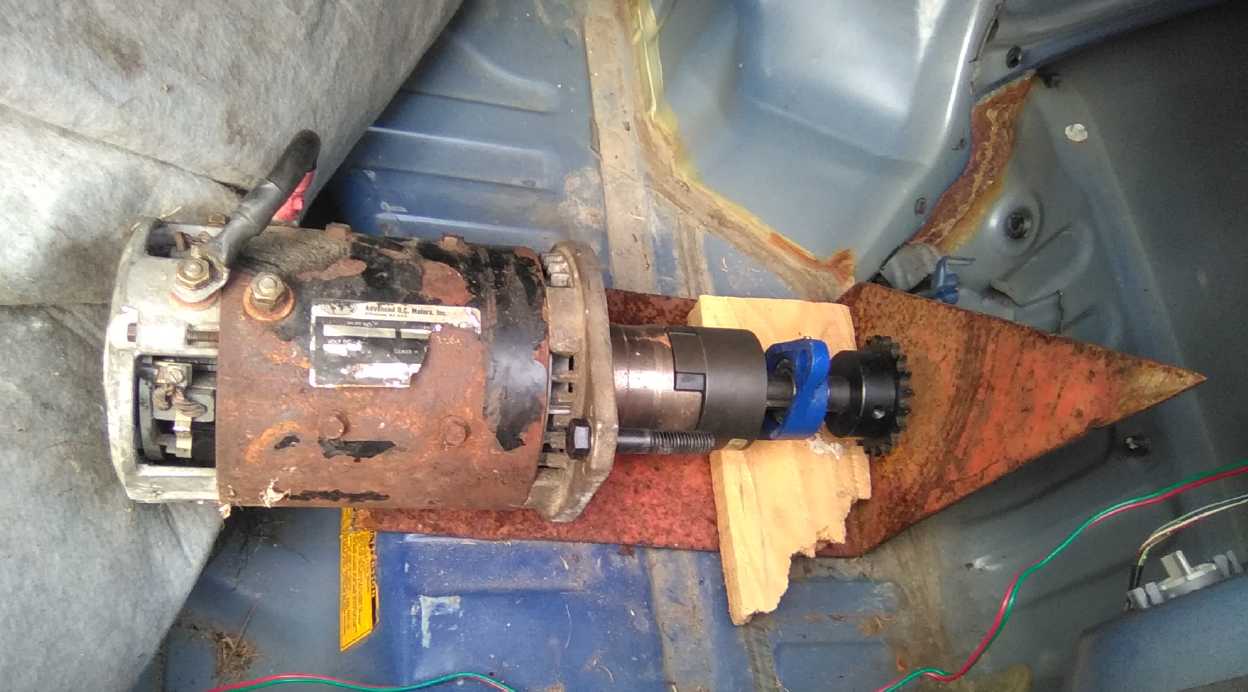 Perhaps the most needed thing is a paint job on
the motor.
Perhaps the most needed thing is a paint job on
the motor.
It works fine as is, but it'd have a better "aura".
There are concerns with the whole idea. A motor in the
trunk will be well above the center of the wheels. So as the car wheel
bounces over bumps, the chain will want to slacken and tighten quite a
bit, and the motor and shaft will have to bounce around a lot to
accommodate that. Mounting it to allow that is surely going to be
the biggest headache. (Toyota is to blame for not making the trunk
lower to
the ground on this side.)
The other big one is that it wouldn't be able to go very
fast with this (2000? RPM) motor; nothing like highway speeds. So
really either this or the Sprint
project would be just a "proof of concept" in anticipation of another
motor - either higher RPM (5000?) or with much more torque so the
reduction ratio can be reduced. (For this it would be nice to still be
living in the city where a car that went 55 KmPH would be adequate for
the streets. 80 is minimal for the highway.)
As to that Sprint direct "motor => planetary reducer
=> CV drive shaft" project: By May 6th the planetary
gear I ordered in mid March had still not arrived. "Departed country of
origin" at last in early April, and nothing more since on the tracking.
I did
ask them to mail it, but oh no, "Things get lost in the mail." It had
to be courier delivery. The mail would have been cheaper than 125$
for no slower delivery. A number of items I ordered through AliExpress
later have arrived in the mail.
I did lose an important parcel in the mail in 2006
(insured), and I know before everything was tracked crooked employees
used to steal things, and the post offices in Canada and USA became
notorious
for losing valuables. That's decades ago now. I think times have
changed since everything more than "small packet" started being
tracked, and corrupt employees are gone. Today nothing an employee
could steal from the mail would be worth the high risk of losing a rare
good job for!
The Low Rolling Resistance Tires
In my trips into town in the Leaf with the new tires (the
four Bridgestone "Ecopia 422+") and in warming weather "mileage" seemed
to be
getting better than ever.
Instead of .9, 1.0, 1.1 or 1.2 kilometers for each percent of battery
charge, I was now getting at least
1.0 or more commonly 1.1 to 1.4. I was getting back
home with around 55 to 60% charge remaining instead of 52 to 56%, or 45
to 50% in
cold weather. And in spite of mostly driving a little faster. My
estimate for the tires' efficiency is still
between 10 and 15% better. And tires improve a little more once they're
"broken in".
But warmer weather is substantially better with both
types of tires. I have noted that sunshine on the pavement (heat!)
gives the best results, while any amount of wetness on the road
(preventing the tires from warming up) is the worst. I'm thinking it
must be possible to formulate tires
that would have their lowest rolling resistance on our usually cool to
cold
roads, around say -5 to 20°C, even if such tires might simply not
be
suitable for (eg) California or Mexico heat.
My biggest conclusion is that I should now start spending
less
time glancing down at readings on the dash and more time watching the
scenery as well as the road.
Handheld Bandsaw Mill Kit
From the 19th I got some work done on this. I cut out two
3/16" steel plates as the bases for
the main wheels at each side of the saw. I got
the idea to mount the guide wheel assembly on the end stop piece so it
won't need its own (third) post at the powered end. Then I welded two
8" posts of 3/4" steel onto each plate. These also hold the guide rails
that determine the depth of the cut.
The guide wheel on the right side has to be free to move
back and forth to set different widths of cuts, so it needs its own
mounting assembly with a post.
I put it together on the "backbone" rails. It looked
pretty good.
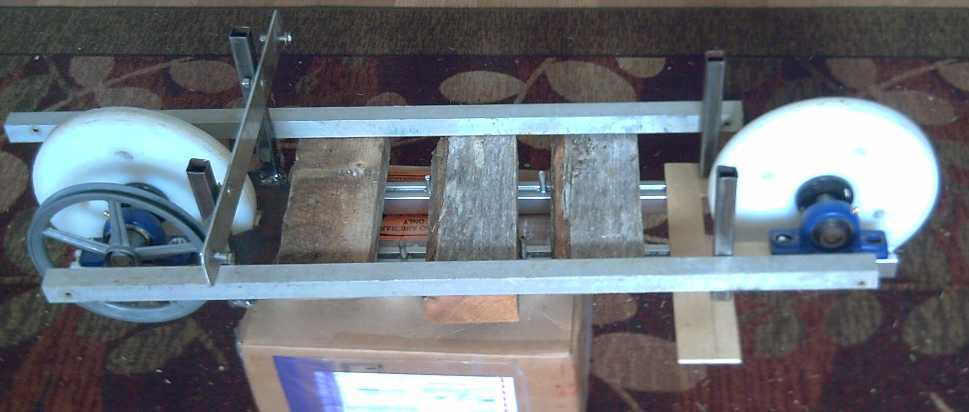 Bandsaw mill mock-up, upside-down.
Bandsaw mill mock-up, upside-down.
The thin bar represents the end stop that buts up against the log or
cant.
The 1 inch tubes (resting on wooden blocks) represent the cut-depth
setting rails,
which must be able to slide up and down and attach securely to the four
posts.
I sized it up for blade bands. With an 82 inch blade, the
two main wheels fit entirely within the length of the backbone rails,
and the
maximum cut width - the distance between the posts - is about 15
inches. With the maximum 93 inch blade that I have been using, the
wheels
stick out past the ends and the maximum possible cut is about 20
inches.... But perhaps more
like 13-14 and 18-19 inches when all is assembled.
A 13 or 14 inch cut width doesn't seem very wide for a
sawmill, but the widest I've ever cut, siding boards on the alder log,
was only
12 or 13 inches at the widest point. I've never needed a wider cut than
that so far. (Of course I diced up the large spruce logs with an alaska
mill and only
tackled the cants, 6 or 8" wide, with the bandsaw mill. Being spruce,
that was plenty to ask of a plug-in powered bandmill and thin bands.)
There's a certain amount of technique that may be employed
to avoid needing a chainsaw mill on logs up to a certain size, even
with a shorter available cut. A 20 inch diameter log is only wide that
at
its center. If having only a 14" cut width, one cuts say a 3 inch strip
off the top, flips it and takes another off the bottom, these cuts
(each narrower than 14 inches we trust) would leave a cant only 14
inches wide when turned sideways, which can then be further sliced up
as desired. (The tricky part is placing the guide board on an angle so
the two cuts are parallel as the log gets thicker toward one end.
Cutting parallel both width and length is an asset!)
If one uses such a technique with a 19" available cut
width, the
low power of the motor will probably become the size limiting factor
unless one is cutting balsa wood.
Cheap Energy
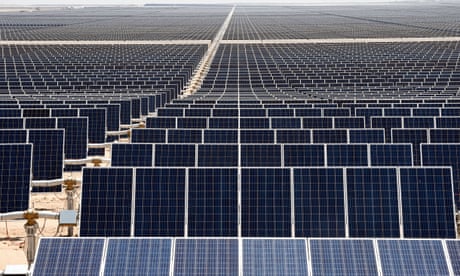 The
International Energy Association has said that solar PV is now the
cheapest energy the world has ever seen, and that we are moving into an
era of "insanely cheap" energy. And that's even without HE ray "free
energy"!
The
International Energy Association has said that solar PV is now the
cheapest energy the world has ever seen, and that we are moving into an
era of "insanely cheap" energy. And that's even without HE ray "free
energy"!
In the earlier stages it wasn't thought that solar PV
would be a serious contender in the global energy market, but the
Australian "Father of Solar Energy" took it from an observed effect of
sunlight hitting silicon chips to a practical energy source, and
continually improved it over three(?) decades. (Here I am telling a
story without even remembering his name!) A city in China lured away
his brilliant Chinese engineer with several million dollars to build a
solar panel factory in that town, and soon it "went big" in China and
elsewhere.
By 2010 new solar installations became cheaper to make per
kilowatt-hour of energy than other types of energy such as nuclear, and
they are perhaps a third of that price now while the cost for other
types has only risen.
Nighttime storage of the very large amounts of energy
obtained is
now the biggest bottleneck to still greater adoption.
I've made some comments about the poorer effectiveness of
solar energy here on the northern west coast with its cloudy weather,
low sun and short winter days under Electricity Generation. Yet
if the power on this island wasn't subsidized to make it a uniform
price across all of BC, the price would be quadruple and solar would be
springing up all over, rapidly.
Supercorder Making Instructions
I wanted to get back to the new chemie batteries, the
Miles EV truck programmer, and the ground effect craft programming.
(Not to mention planting the garden, finishing the carport, working on
the cabin, making another firewood shed and cutting next winter's
firewood.)
 A Supercorder in African Blackwood with
Nickel-Brass Keys
A Supercorder in African Blackwood with
Nickel-Brass Keys
Instead I suddenly got the idea to put instructions for
making my Supercorder on line on about the 28th, and I spent
the whole 29th making a start at writing those up. I don't know why I
didn't think of doing that years ago! I wasn't writing anything like
Turquoise Energy News back in 2003-2006 when I created them, so there's
no "how-to", and I would like to see them being made - by anyone,
anywhere - rather than the whole grand design for a beautiful
instrument that should be making wonderful music everywhere being lost.
So between that and the handheld bandsaw mill kit, I've
been spending time working on old "finished" inventions, to give them
value. And company arrived for a few days and the month came to an end.
In Passing
(Miscellaneous topics, editorial comments & opinionated rants)
Titan's
Elliptical
Orbit
Titan is not just some
"oid", being between Mercury and Mars in size and having a nitrogen
atmosphere of similar pressure to Earth's. By itself it is 96% of the
mass of all the things in orbit around Saturn. I have long wondered
about Titan's slightly
elliptical orbit about Saturn. It has been said that it should have
circularized long ago over the age of the solar system, but it hasn't.
This 2% eccentricity makes for Titan's fascinating once daily tides (16
Earth days) with a powerful 9 meter impulse, compared with Earth's
twice
daily tides with a .5 meter impulse. These tides drive Titan's shallow
seas
of relatively pure liquid methane into a complex geometric pattern
around the equator, with areas of undersea "dunes" that extend for
hundreds of kilometers, from 400 meters depth to the surface. The
inevitable and
obvious conclusion is that something is keeping the orbit elliptical.
Two other worlds worlds seem to be involved in this:
Iapetus, Saturn's next and outermost regular moon out from Titan, and
tiny "potato" Hyperion with an irregular orbit between them.
Hyperion, in a complex resonance that brings it very near
Titan, makes 3 orbits of Saturn for every 4 of Titan. (Its extreme
tidal bulge "potato" shape is probably a result of passing very close
to Titan at some point, plus having little gravity to draw itself back
into a sphere. It is known to rotate to point at Titan when it gets
close to it,
causing it to "tumble" instead of always keeping its long axis pointed
toward Saturn.)
Iapetus also has a 2% elliptical orbit with 5 times the
period of Titan. Yet not exactly 5 times:
Titan: 15.94542 Earth Days
Hyperion: 21.27661 E.D.
Iapetus: 79.33018 E.D.
Titan * 4/3 = 21.26056
Titan * 5 = 79.7271
Discrepancies:
Hyperion: 21.27661 / 21.26056 = +.000755
Iapetus: 79.33018 / 79.7271 = -
Although the Titan/Hyperion 4/3 ratio isn't 100% exact,
scientists say a gradual precession of orbits (over a 20 Earth year
cycle) accounts for the difference. However, they say the same isn't
true of Iapetus - that its orbit isn't resonant with Titan's;
precession can't account for the difference. (I remember once trying to
work
it out for myself (I don't remember how), and that seemed to be true.)
And yet we have the undeniable fact that all their orbits stay
elliptical
and there is simply nothing else that can account for it. And Iapetus
is so close to exactly 1 orbit per 5 of Titan as to be more than
slightly suspicious. We must be missing something, some subtle
complexity to the relationship that we haven't figured out.
But I have just learned something I hadn't known before:
Iapetus' orbit is inclined 15.5° from Saturn's equatorial plane,
where the other moons orbit pretty closely to it. Without knowing how
to calculate the orbital mechanics, I say AHA! Something in that
orbital inclination must
explain that Titan, Hyperion and Iapetus are somehow in resonance after
all and causing each others' orbits to remain elliptical. Perhaps
Iapetus' inclination precesses in resonance with Hyperion and or Titan?
We may find there's another resonance over a still longer period of
time, maybe even hundreds or thousands of Earth years. After all, Earth
has some extremely long known cycles such as the wobble of its orbital
inclination. (11,000 years, was it?)
An interesting note is that Iapetus can be closest to the
others when it is crossing the equatorial plane where Titan and
Hyperion are, twice per orbit. One suspects the interactions are
probably somehow also tugging Iapetus into its relatively steep orbital
inclination as well as causing the slight orbital eccentricities. The
clues of what's going on are doubtless there for us to figure out.
(my writings on this fascinating world ~ 2005-2008: Living Titan: https://www.saers.com/recorder/craig/titan
)
Auroras
of
Ganymede
 Ganymede has
a magnetic field rather similar
to Earth's. Lately astronomers have used one o' them fancy new
telescopes to image its auroral displays. (Well, I can't remember the
details.)
Ganymede has
a magnetic field rather similar
to Earth's. Lately astronomers have used one o' them fancy new
telescopes to image its auroral displays. (Well, I can't remember the
details.)
One may observe that the more equatorial area is darker
than the more polar regions beyond the auroras, perhaps indicating that
the fluffy layer of reddish complex organic materials thrives better
where
protected by the magnetic field from "cosmic rays" (high energy charged
particles) and Jupiter's ionizing radiation.
Thus Ganymede (diameter ~5260 Km) would be friendlier to
space visitors than Mars (diameter 6787 Km), where "cosmic rays" are
free to blast right in to the surface.
Outside of magneticly protected areas, there is also a
hemispheric difference where Jupiter's ionizing radiation, swept around
with its 12 hour rotation, blasts the trailing hemisphere but not the
leading one.
This is most noticeable on Callisto and especially
Saturn's small moon Iapetus, where astronomers have long noted that the
rear is almost as reflective as ice, but the front is "as dark as
coal", and from the Cassini probe, "very fluffy".
Small
Thots
* It seems that new CDC statistics
indicate that as few as 6% of those in the USA said to have died of
CoViD had CoViD and nothing else. The other 94% had at least
potentially fatal co-morbidities that were at least major contributing
factors if not the actual cause of death. Hospitals have been getting
substantial extra money to handle "CoViD deaths", so they have a strong
incentive to report every death possible as "CoViD" regardless of the
actual cause. Hospitals have admitted to misleadingly counting at least
130,000 deaths as "CoViD" which were actually from other causes such as
pneumonia, flu and heart attack. Herein is no doubt a main reason the
USA has been
reporting a much higher incidence of "CoViD" deaths than other
countries. (And why flu seems to have almost died out?) The original
number of deaths said to be from CoViD was 345,000. 6% of this is just
21,000, or even 33% is just 115,000 - more in line with many other
nations' CoViD death rates and - not to minimize the seriousness or
contagiousness of CoViD - rather similar to regular seasonal influenza.
 Even so, both heart disease and cancer each killed almost
twice as many people as were previously reported to have died of the
virus. Yet there is no big push being made to eliminate these "more
epidemic" causes of death. Society isn't being disrupted and shut down
- not even the "worst culprit" foods and drinks are being pointed out.
No one is being lectured about healthier diets or the need to
take vitamin D to be resistant to cancer if you're not getting out in
the sunshine.
Even so, both heart disease and cancer each killed almost
twice as many people as were previously reported to have died of the
virus. Yet there is no big push being made to eliminate these "more
epidemic" causes of death. Society isn't being disrupted and shut down
- not even the "worst culprit" foods and drinks are being pointed out.
No one is being lectured about healthier diets or the need to
take vitamin D to be resistant to cancer if you're not getting out in
the sunshine.
* Local statistics as far as I have
heard (accuracy is by no means guaranteed) from Haida Gwaii, pop. 4500
or so:
Deaths from Covid: 0
Deaths from Covid Vaccine: 4.
Of course one must note that that is out of two or three
thousand vaccine doses, and also that if the vaccine is 100% effective,
it only makes sense that all of very few deaths among those vaccinated
must be from the vaccine, which has prevented the disease. And
statisticly it is said that rates of CoViD are down substantially among
the vaccinated.
I wonder how many deaths there have been here from other
causes
in the last year? If we all live to age 100, and all else being equal
(but of course there are many factors), one would expect around
45 deaths per year here total.
* A head person at CNN was secretly filmed while saying (among other
disturbing things) that fear
gets ratings, and nothing gets ratings like CoViD, so they've been
hyping it
for all it's worth. He said next they plan to hype global warming
again.
But mass media viewership has declined substantially in the last year.
* There seem to be a growing number of new strains of CoViD. As with
influenza,
vaccination for the original one is unlikely to confer immunity to
others. Someone was saying that the efforts to slow the disease -
lockdowns and vaccines - are helping it to mutate much faster. I
didn't really follow the logic behind this assertion.
* Sign at the ferry terminal, in lights like a highway construction
sign: "Essential travel only" - blink - No recreational travel" - blink
- stay local - (back to 1st)
This isn't a good way to advertise to get business!
Apparently the public is marooned on this
island, and also on Vancouver Island! And wherever else they are! One
might hope the insanity would
end. Instead, so far, it has been getting worse and worse.
* Texas however has reopened everything, and now (after many dire
warnings from politicians and the media of the doom and gloom and mass
death that
would follow such a reckless move) their rate of new covid cases is
lower than locked-down states. Statistics are now
starting to show that none of the lockdowns, shutdowns, masks and other
measures
tying everyones' hands have had any significant effect on the spread of
the virus. It has spread virtually the same in nations and states with
or without such craziness.
* Is it time to call the whole thing off? And give out Ivermectin pills
to cure the ill as some Eastern European countries have now started
doing, instead?
...and vitamin D to improve resistance to both CoViD and cancer?
---
* My hair has definitely gotten thicker since writing about hair loss
in (at least) TE News #139, 137, 140 and 141. If I part it in the
middle it now looks like an ordinary part instead of a very wide part
showing lots of skin. The top-back area is much improved too, although
it doesn't seem like "full thickness" yet.
I think the weekly scalp spray and rub with (ethyl)
alcohol before
a shower keeps the Demodex mites at bay to prevent further hair loss,
and stimulation of the scalp by fairly gently rocking a hair brush back
and forth on it (not a brush with a little ball on the end of
each bristle). I've only been doing that for 3 or 4 months, and it
seems to have really
helped get it growing again where it was thin. (In lieu of that,
perhaps a "scalp roller", eg from AliExpress.com, is probably a good
stimulator? I ordered one once to try it out, but it never came.)
Now, why is my hair starting to get so much gray in it?
I'm only 66!
* Having mirrors placed in your bathroom so you can see your back side
is really helpful. (In my bathroom a "full length" mirror hanging on
the door works great combined with the three medicine cabinet door
mirrors
across from it, which each must be aimed at the best angle to give rear
views at good angles with the door mirror.)
ESD
(Eccentric Silliness Department)
* Year after year we celebrate Easter. When do we get to celebrate
Wester?
* I C Y. Do U C Y?
* Times change. How many houses and buildings have candles burned down?
Perhaps in this new age we should change the little rhyme:
"The butcher, the baker, the LED maker".
* Some people do very fine welding. I occasionally do astounding
welding. I am always astounded when two pieces I weld together don't
come
apart! (Another 10 years and I'll be as good as the kids in first year
trades school!)
* Some heavily processed junk foods can't really be said to have a
shelf life - rather, they have a half life. [per Perry, grocer]
* Deer hunting season is over. Garden raiding season has started. For
the deer.
* I found a Canadian Tire flyer that said "Canada's Spring Store". I
looked through all the pages but couldn't find a single spring!
"in depth reports" for
each project are below. I hope they may be useful to anyone who wants
to get into a similar project, to glean ideas for how something
might be done, as well as things that might have been tried, or just
thought
of and not tried... and even of how not to do something - why
it didn't
work or proved impractical. Sometimes they set out inventive thoughts
almost as they occur - and are the actual organization and elaboration
in writing of those thoughts. They are thus partly a diary and are not
extensively proof-read for literary perfection, consistency,
completeness and elimination of duplications before
publication. I hope they may add to the body of wisdom for other
researchers and developers to help them find more productive paths and
avoid potential pitfalls and dead ends.
A
Modified
100%
Efficient
Torque
Converter Assembly
[9th] For some reason I got back on AliExpress looking at planetary
gears. I noticed one with a round body. This time I also had in mind
the other
recent idea of going in-line from a planetary gear straight to a CV
drive shaft or a wheel. That got me to thinking... that instead of
driving a gear or chain sprocket to a differential from the torque
converter, one might use it in-line the same way.
I thought about it again, and came up with needing the
same gear
configuration for the torque converter, in order that the
forces all act in the same direction rather than oppose each other:
- motor drives the planet assembly gears
- sun gear drives the shoes of the centrifugal clutch (highest
speed point for centrifugal action)
- ring gear has the outer centrifugal drum, and drives the car.
(Will turn the same direction as the shoes as it starts turning.)
The trouble is I couldn't see how to arrange that. To have
the ring gear be one end to drive the wheel/drive shaft, the planets
and sun gear would both have to be concentric on the other. And somehow
the planets would have to be on the inside shaft to connect to the
motor, with the sun gear outside to turn the centrifugal shoes. It's
not
that such a thing couldn't be created, but I doubt if anyone makes one
configured that way, and I expect creating a hollow centered sun gear
with a hollow shaft (that the shaft of the planets assembly can run
through) is beyond my capability.
But Wait! Aha! The ring gear also connects to the
centrifugal drum. The drum
can have two solid faces. One is attached to the ring gear. Then the
outside face is beyond the centrifugal shoes within - it is at the very
end with nothing else sticking out past it. So the outside face can
connect to the drive shaft or wheel. Then only a regular planetary
gear is required! No custom parts except
the special centrifugal clutch. What is usually the output shaft
(planets) connects to the motor shaft. The socket that usually connects
to the motor gets a shaft to turn the centrifugal shoes, which is
inside the two-faced outer drum. This should simplify the whole idea.
Should I want to put one on the Miles mini cargo truck, it
could drive the existing rear differential, which
provides about a 2 to 1 "final reduction ratio". So with a variable
torque converter fully engaged (1 to 1 ratio) the motor
would spin twice as fast as the wheels, which seems desirable, and it
should easily attain highway speeds.
On the Sprint car the motor speed is doubtless too low
with
direct drive to the wheel (only 1000 RPM at 100 KmPH), so one might
employ a second planetary gear
in-line after the torque converter one for a fixed "final reduction
ratio", again probably about 2 to 1 or higher, depending how high one
wishes the motor to rev at highway speeds - which of course depends on
the motor.
But a lot will depend on just how the torque converter
performs at what RPM. And that depends on the ratios of the planetary
used, the output shaft speed before final (again planetary) gear
reduction,
and the performance of the centrifugal clutch.
Miles
electric
cargo
truck
delayed
project
Killer Battery Dischargers!
[8th] I decided to use six 100 amp-hour, 12 volt
lithium-iron phosphate (LiPO) batteries for the 72 volt drive. I took
out the six remaining 70 pound golf cart batteries. Between the
unwiring and the weight, that ended the afternoon.
With around 840 pounds (for all twelve) removed and six 30
pound LiPOs added, total lightening of the truck would be 660 pounds.
Not insignificant!
And given one shouldn't discharge PbPb's to less than 50%
remaining, their 180 amp-hours rating is the same as the 100 amp-hours
of the new batteries, which can be discharged to 10%. And being 660
pounds lighter the vehicle should go farther for the same energy. At
least that's
the theory: in practice, the golf cart batteries were all failing
anyway, and half the LiPO's were
as old as the truck, considerably used (the were from the Suzuki Swift)
and hence it's doubtful they had full capacity.
 But I found that the LiPOs that were already in the truck
were horribly swollen up! Had they been badly overcharged too? Frozen?
(In the garage?!?) To my shock they all read 0.0 volts! The other
possibility then was
that they had been totally discharged. (They swell up if they're
discharged?) I had left them fully charged in the truck, but assuming
there was no load on them if the truck was shut off, I hadn't looked at
it for months. It had no clock, no radio, and the contactor solenoid
shut
off the motor controller when the key was off -- what on Earth would
draw current if it was shut off? Apparently there must be
something. Sh*t! That doubtless explained the deteriorations and
pretty much demise of the lead-acids over time, too. In all the time
I've had the truck I never suspected that they were always under load -
however light - rather than being idle. Why didn't I think of it? So
many newer vehicles (well, since around ?1985) draw current and drain
the battery even while they're sitting. But how much does it draw,
anyway, that it would drain several kilowatt-hours, even over a few
months? [calculating...] Well it would have to be well over a watt
rather than milliwatts. Obviously
I should have disconnected the batteries entirely when I put the truck
away. For the future I'll put a 500 amp fuse at the 36 volt point, that
I can disconnect if I'm not going to be using the truck. (By putting it
at the middle point, even if the system should become grounded
somewhere that's okay to touch.)
But I found that the LiPOs that were already in the truck
were horribly swollen up! Had they been badly overcharged too? Frozen?
(In the garage?!?) To my shock they all read 0.0 volts! The other
possibility then was
that they had been totally discharged. (They swell up if they're
discharged?) I had left them fully charged in the truck, but assuming
there was no load on them if the truck was shut off, I hadn't looked at
it for months. It had no clock, no radio, and the contactor solenoid
shut
off the motor controller when the key was off -- what on Earth would
draw current if it was shut off? Apparently there must be
something. Sh*t! That doubtless explained the deteriorations and
pretty much demise of the lead-acids over time, too. In all the time
I've had the truck I never suspected that they were always under load -
however light - rather than being idle. Why didn't I think of it? So
many newer vehicles (well, since around ?1985) draw current and drain
the battery even while they're sitting. But how much does it draw,
anyway, that it would drain several kilowatt-hours, even over a few
months? [calculating...] Well it would have to be well over a watt
rather than milliwatts. Obviously
I should have disconnected the batteries entirely when I put the truck
away. For the future I'll put a 500 amp fuse at the 36 volt point, that
I can disconnect if I'm not going to be using the truck. (By putting it
at the middle point, even if the system should become grounded
somewhere that's okay to touch.)
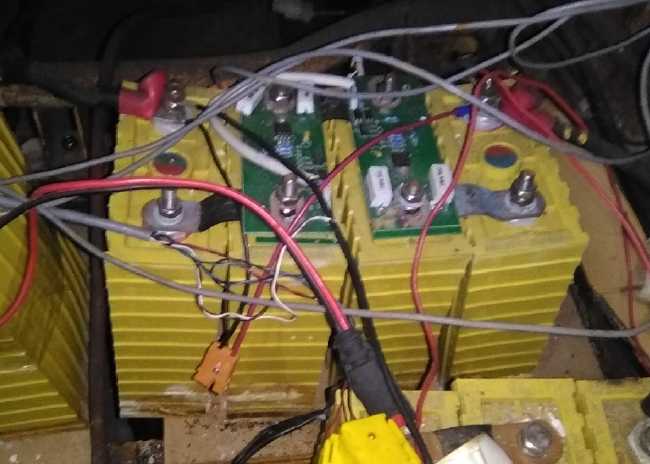
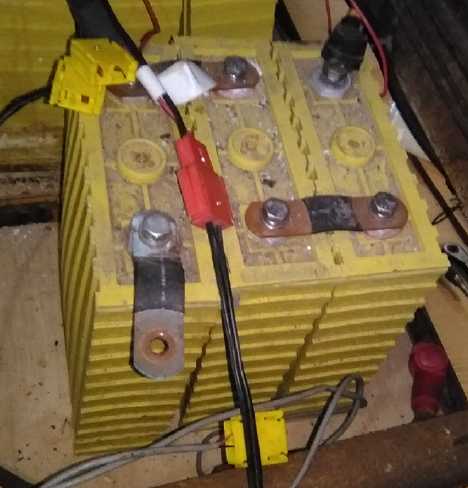 Totally discharged, swollen up LiPO cells.
Totally discharged, swollen up LiPO cells.
Thanks, "Delta-Q" Battery Discharger!
I had 8 sets of the LiPOs. That was supposed to do the
truck with 2 to spare. If 3 were now no good, that left me just 5 where
the truck needed 6. Oh, no! Here was a disheartening development. These
things aren't cheap, even ordered from China. Too bad I sold some of
them. I thought I had more than enough left.
Assuming they had been discharged I went to charge them
and see what would happen. I got out a lab power supply and set it to
10 volts (they might charge unevenly so I kept it low to start with)
and its maximum
of 5.5 amps. Gradually the voltage started to creep up, but painfully
slowly. and unevenly between cells. What would happen? LiPOs aren't
supposed to explode. But. They're also not supposed to be allowed to go
below 2.8 volts per cell. If they had been at zero for weeks or months,
would they recharge at all? If they did, would they have full capacity
or way less than their rating? Or would they explode anyway? After a
while it became apparent that the voltage wouldn't rise to halfway and
that the batteries were completely ruined. In fact it started dropping
again even with all the current going in. A sickening waste of what had
been good batteries.
That leaves using:
(a) three of the five good LiPO batteries and one of the new
lithium-ion stacks for the other 36 volts, or
(b) The two assembled lithium ion stacks (leaving the unassembled one),
or
(c) buying at least one new set of four LiPOs. (500-600 $) Still leaves
3 older well used sets that may not last too long in vehicle use. (The
other two sets are better)
(a) seemed the most practical. I had been hoping to
put all three of the 36V, 120AH LiIon stacks into the Sprint in
parallel. Or at least the two
assembled ones for now. I guess I'll have to assemble that third stack
sooner rather than later. (Or rob the truck when I go to try out the
car.) Let's see... a 40 pound 36V stack instead of three 30 pound 12V
batteries means another 50 pounds off the weight, so total weight
reduction from the twelve golf cart batteries is 710 pounds.
Perhaps another good battery deal will come my way some
time? (Even if I get my nickel manganates - zinc cells working great I
don't have much confidence for producing enough to put into a car any
time soon. Especially not by making C cells!)

I re-installed the now
balanced (or at least
centered/straight) shaft I'd made to connect the 5:1 planetary gear to
the truck motor. It was also now welded so the two shaft coupler joints
couldn't shift and it would stay centered.
 Right to Left:
Right to Left:
Back of Curtis AC35 motor; the shaft; the shiny 5:1 planetary gearset
with
angle bracket & plate - a somewhat cushioned mounting to frame;
(dark) socket and U-joint of drive shaft to rear sheels.
Then I set the batteries in, and then connected them. Then
I checked the battery voltages and found a couple were down more than I
liked. I connected some chargers using an extension cord and a power
bar and left it a while. So I cleaned up in and around the truck - long
overdue.
At the end of the day I tried it out, just in the garage.
It powered up and drove backward and forward. YAY!
When I quit for the day I disconnected the fuse that I put
in-line. Why would I trust it?

Then some proper chargers. I thought maybe I should just
get two 40 or 50 volt lab power supplies and set them to optimum
voltage for the balance chargers: maybe 42 volts for the 12S
lithium-iron phosphates and 40 for the 10S lithium-ions. (or I could
reduce the PO4s to 11S. Then 40V would be enough.)
That night I went to AliExpress, but the lab units were
uniformly "0-30V, 10A" or else "0-60V, 5A". 10 amps seems like a good
minimum. An overnight charge seems reasonable, but to charge a 100
amp-hour battery at 5 amps could take most of a whole day. After much
further searching I found an "OEM" power supply that was 40V, 10A, with
an adjustment screw plus or minus 10%, so presumably about 36 to 44
volts. Runs on 110 or 220 volts AC. They were about 45$. Perfect! I
ordered three - two for the truck and one for the Sprint.
[15th] I was wondering why the one LiPO battery from the Sprint had
been so low - 12.8 volts instead of the usual 13.5 or so. It seemed all
four of its cells were maybe 80 or 90% discharged. It was taking many
hours to
recharge. Then it occurred to me: one of them out of two had been
plugged into a "Genius" charger from Canadian Tire, set to "Lithium".
The other had the double 6 volt charging system I had made for balanced
charging. I had put in diodes to make sure it would only charge.
But the "Imbecile" charger (I'll not call it "Genius"!) must have been
drawing current from the
other battery when it wasn't powered up! It's supposed to be a charger,
not a discharger! I supposed if I'd left it very much longer this
battery would have suffered the same fate as the ones in the truck.
I'll have to watch for that with the new power supplies and if
necessary (probably) put high current diodes in series so they can't
become dischargers. (The "12S" and "10S" balance chargers might prevent
discharge, but I'm not counting on it. In fact, I hope they don't cause
discharge themselves! The charge on the stack isn't as high as it was
when I unplugged the stack from charging some time back, either. Hmm! I
disconnected the 11 pin plug just in case.)
Then I suddenly realized that's what it must be on the
truck: the "Delta-Q" 72 volt battery charger must surely be what was
discharging the batteries! The longer I go the more I hate those
chargers. First the Swift fire, then this one boiled the golf cart
batteries completely dry (probably after draining their charge entirely
more than once
first), now it has destroyed three LiPO's as well (and whatever was
left of the last six golf cart batteries) -- and it wasn't even being
used! Add "remove old charger" to the list of truck jobs. Later I put
the mulitmeter on "10 amps" scale across the disconnected fuse and
found that something was in fact drawing over .6 amps with the key not
even in the ignition! The current seemed to be dropping ever so slowly,
but at
that rate even 100 amp-hour batteries would be dead in two weeks.
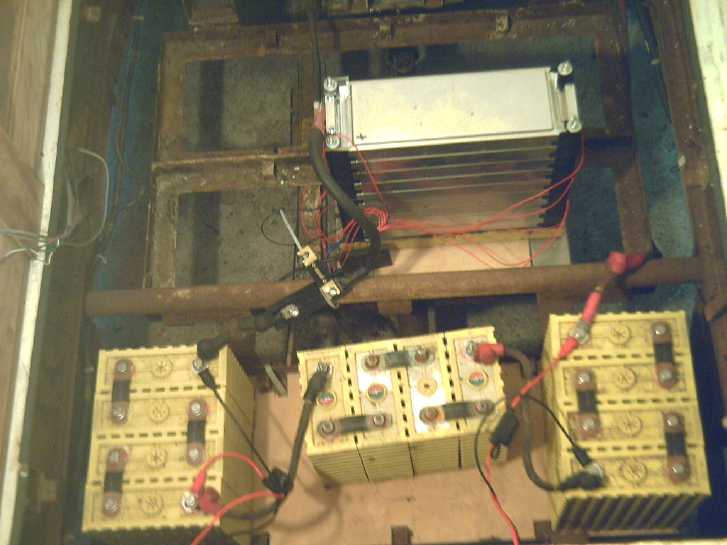 With the tall stack of LiIon's too likely to fall over, I made
a couple of aluminum brackets, drilled some holes, and bolted it into
place.
This time I moved "the place" over toward the middle so I could get a
screwdriver in behind to undo the screws and connect meters on the dash
to show
battery voltages.
With the tall stack of LiIon's too likely to fall over, I made
a couple of aluminum brackets, drilled some holes, and bolted it into
place.
This time I moved "the place" over toward the middle so I could get a
screwdriver in behind to undo the screws and connect meters on the dash
to show
battery voltages.
(I should strap down the 3 LiPO's too. And the fuse holder
is just strapped down with a cable tie. And I'm not fussy about it all
being open to the road beneath. Perhaps I'll enclose it all with
plywood.)
When it was mounted and reconnected I didn't see
anything to prevent a test drive.
I backed the truck out of
the garage and started to circle
around the driveway. The drive shaft started slipping or skipping when
I tried to go uphill. I checked underneath and found the socket screw
in the planetary was loose, although I had tightened it all I could
when I assembled it. (ONE silly little socket screw to hold all that
torque??) I tightened it up and it seemed okay. I drove it back into
the garage. I had
noticed that the shaft splines were sticking out a bit from the motor
socket. I thought they were usually right inside. Had the whole shaft
slipped back too far, or was it okay? STILL not done with this cyrsid
shaft? But assuming it's fine now, next job is seeing what's up with
the
handheld programmer - why doesn't it seem to work right?
I'm not going to do much or any driving until I have
proper chargers. Or 2 x 36V solar panel chargers: Two on the roof, with
or without two 'extra' panels that swing up from the sides of the box
when the truck is parked.
Toyota
Echo Plug-in Hybrid Conversion?
I started thinking again about the idea of turning the
Echo into a plug-in hybrid with an electric drive on the rear wheel.
It's a good car. In some ways I like it better than the Nissan Leaf.
I'm short of EV batteries, but if I could make it work - and work well,
for the highway - I could sell the Leaf and have a lot of money for
more batteries!
Then I started thinking about all the little things it
needed. [Well, you can skip down from here to the next white space
below the taillight pictures from here!]
What about the cracked windshield? And the broken tail light? And the
non-functional parking brake (ever since I changed rear brake shoes)?
And then how about that intermittent and noisy cab air fan? And the
dash lights that only work sometimes? And the much pitted, fogged-up
plastic headlights? It could use some cleanup and a vacuuming, too!
With 420 Megameters on it, it could hardly be expected to be like new.

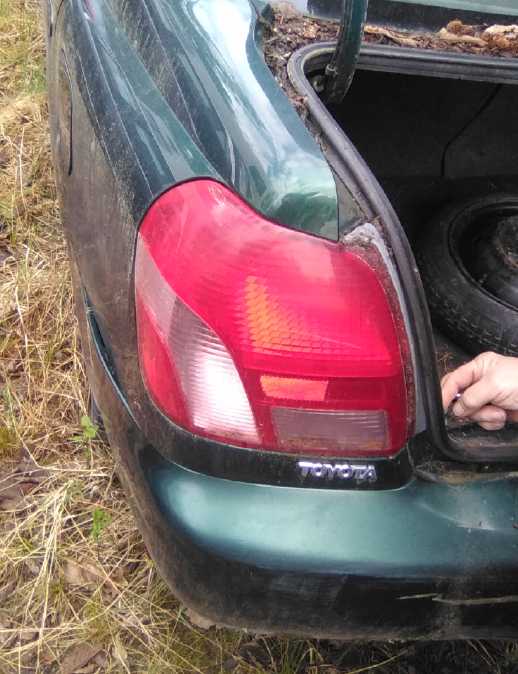 YAY! A junked car with the same tail lights as
my cracked ones!
YAY! A junked car with the same tail lights as
my cracked ones!
On the 24th I noticed the other tail light had a crack in
it as well and fine dirt was getting in. Doubtless I'd have noticed it
earlier if the broken one with all the "Tuc" tape around it didn't draw
one's attention away. I asked Paul if he might have a wrecked Toyota
Echo and got two "new" tail light assemblies at his wrecking yard in
Port Clements, from a corroded 2000 Echo (one year older than mine). I
disassembled, washed and installed them, bashed out a few dents around
the one that had been broken, and sprayed on some rust primer paint.
(Now, if I'd been prescient earlier, I could probably have got the
alternator off the wrecked Echo for a lot less than 335$! Hmm, are
there any other parts the car needs that might be had from it?)
Then I fixed the rear/parking brake. (I had
re-assembled it wrong last time - a little "self-adjustment ratchet"
was sprung out of place. I only figured it out thanks once again to
someone on youtube showing how-to!) Then I drove the car up on ramps
twice and sprayed "Fluid Film" over all the rear, and then front,
steering, springs and suspension parts and joints around the wheels to
ward off further corrosion.
Now about that windshield... There was one on the scrapped
Echo, but watching a how-to video convinced me I didn't want to do it
myself except as a last resort. And a brand new windshield is always
clearest - if costly. (Rock chips in windshields have convinced me to
slow down on the highway in winter when there's gravel on the road, and
still more whenever another vehicle is approaching. I think dropping
down to 50 KmPH saved
my Leaf windshield at least once when a big truck passed by.)
I pulled out the formed upholstery obscuring the right
wall of the trunk, and began to think that if I simply mounted a motor
in the trunk and put a really heavy spring on it to tension the chain,
it could propel the car. It would need one hole through the sheet metal
and the plastic bumper for the shaft with the sprocket on it.

The only motor I have that I'd want to try this with
(without making
the long planned unipolar BLDC and a controller for it) is probably the
forklift motor. Wait, that motor was for the Sprint! It looks like I
have to pick one project or the other. Unfortunately, I now really only
have batteries for one EV project, too. Two if I stretch it and maybe
resurrect some golf cart batteries for the house solar.
 I
dug out the 120 tooth, #40 chain sprocket that I had
made to fit on a car wheel, and I pulled out a 20 tooth one (from 2016
experiments) that would give it 6 to 1 reduction. By having a gear
almost as large as the wheel (hopefully I didn't go TOO large - there's
not much ground clearance if the tire is low), the forces on the chain
are reduced. With a smaller gear a #50 or #60 chain might be a better
choice. I expect #40 chain, wrapping around larger sprockets, will have
lower losses and last longer.
I
dug out the 120 tooth, #40 chain sprocket that I had
made to fit on a car wheel, and I pulled out a 20 tooth one (from 2016
experiments) that would give it 6 to 1 reduction. By having a gear
almost as large as the wheel (hopefully I didn't go TOO large - there's
not much ground clearance if the tire is low), the forces on the chain
are reduced. With a smaller gear a #50 or #60 chain might be a better
choice. I expect #40 chain, wrapping around larger sprockets, will have
lower losses and last longer.
Another viable choice with the larger sizes might be a
poly-V or flat belt instead of chain. Those are said to be almost 99%
efficient and are very quiet - as long as they don't slip. (I'm less
sure about the efficiency of toothed belts.)
[26th] After hooking up the trailer and
driving into town to buy
enough plywood to finish the cabin (before the price goes up!), I got
out the motor,
got the other half of the lovejoy connector from the original Sprint
transmission, and rounded up a few more potential parts. The idea is
simple; exactly how to actually do everything is going to get
complicated.
My biggest concern - all along for trying out this idea -
with a motor in the trunk
is that it will be well above the center of the wheels. So as the car
bounces over bumps, the chain will want to slacken and tighten quite a
bit, and the motor and shaft will have to bounce around a lot to
accommodate that. It's almost as if Toyota's engineers never
contemplated
this sort of electric conversion when they designed the car! Somehow
I'm reluctant to chop out part of the floor of the trunk in order to
mount the
motor lower. Is that just a silly mental block? Hmm!
[May5th] Say, I should mount the motor and sprocket to a vertical plate
that can easily spring back an forth, not to a horizontal one that has
to lift and fall a ways in order to go back and forth. Or, say, not
quite vertical but perpendicular to the line from the motor to the
center of the wheel. Yes, that would be optimum!
But the real problem is that the car won't go very fast.
If the Sprint (10" tire radius) only did 25 KmPH with a 9 to 1
reduction from this motor, the Echo (11") is probably just going to hit
40 with 6 to 1. That's nothing like highway speed. And in fact one
would much over-rev the motor if one drove too fast under gasoline
power with the electric system connected. The reason for doing it then
is really just to try it out in principle and anticipate getting or
making some other motor later. But a 5000 RPM motor instead of (?)2000
would allow 100 KmPH, or a very high torque motor might deliver
sufficient thrust with a lower reduction ratio.
It would be pretty much the same with the Sprint "motor to
planetary gear reduction to wheel shaft" project. If I'm not going to
make the unipolar BLDC motors and controllers any time soon, perhaps I
should hunt around for a more suitable motor for whichever project I
pursue?
Other "Green" Electric Equipment Projects
Handheld Bandsaw
Mill Kit
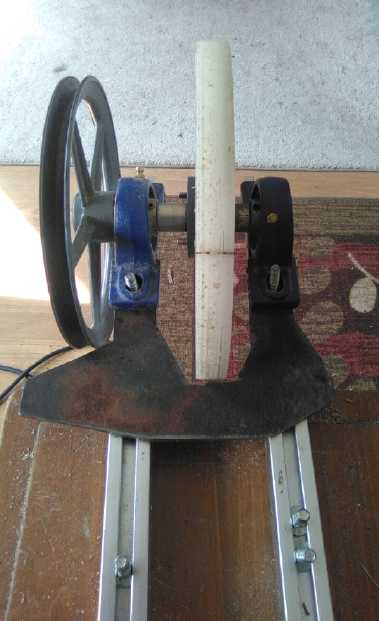 [19th] I got
around to cutting out a 3/16" steel plate as the base for
the powered side of the saw. I had made marking on the wood, now used
those to size up the steel. I drilled the bolt holes and tried it out.
After a couple of small cuts to trim it, it seemed about right. I have
the idea to mount the guide wheel assembly on the end stops, so it
won't need a separate (third) post.
[19th] I got
around to cutting out a 3/16" steel plate as the base for
the powered side of the saw. I had made marking on the wood, now used
those to size up the steel. I drilled the bolt holes and tried it out.
After a couple of small cuts to trim it, it seemed about right. I have
the idea to mount the guide wheel assembly on the end stops, so it
won't need a separate (third) post.
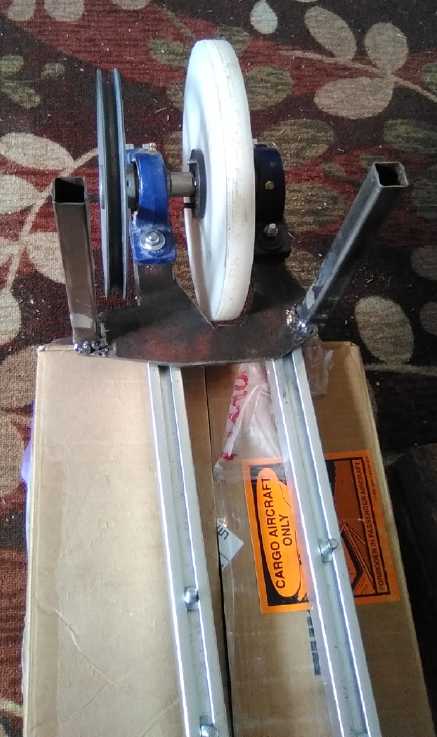 [21st] I welded on two 8
inch posts of 3/4 inch square steel tubing to
this base for mounting the depth setting bars, the left end stop/guide
and the left side band guide wheel assembly. Then, having all the
equipment out on the lawn, I made a mirror image copy for the right
end. The plate is actually identical - just turn it over.
[21st] I welded on two 8
inch posts of 3/4 inch square steel tubing to
this base for mounting the depth setting bars, the left end stop/guide
and the left side band guide wheel assembly. Then, having all the
equipment out on the lawn, I made a mirror image copy for the right
end. The plate is actually identical - just turn it over.
This time instead of
cutting the complex shape with the
angle grinder and a jigsaw with a metal cutting blade, I remembered I
had bought a plasma cutter a while back. I got it out and cut it with
that. No doubt it was faster cutting than anything else, but it made
the ugliest cuts, with bits of slag everywhere, that I had to spend
quite some time cleaning it all up. And I used up a cutting disk on the
angle grinder doing so, so I only saved one zip disk, and probably 1/2
a
metal cutting jigsaw blade. But I may get better with practice?
Then I welded 7 inch posts to that plate. (instead of 8":
At the right end they don't hold the end stop/guide and so don't really
need to go below the blade.) And drilled the bolt holes.
 I put it
together on the "backbone" rails. It looked
pretty good. Of course for production I will draw out the plates in a
CAD program and
then send them off to be CNC waterjet cut. (...unless I get my own
plasma cutter working on the CNC platform. Well, not this month.)
I put it
together on the "backbone" rails. It looked
pretty good. Of course for production I will draw out the plates in a
CAD program and
then send them off to be CNC waterjet cut. (...unless I get my own
plasma cutter working on the CNC platform. Well, not this month.)
But I noted one conceptual flaw: the flat end stop piece
will prevent the cutting depth guides from being set to thinner than
the width of the part of the stop above the band. Having cut some
myself, I just know that people will want to cut about 1/4 to 3/8 inch
thick guitar backs and bellies with this nearly zero kerf mill! (Maybe
even cut veneer?) It would probably be easier and have less waste than
with a shop bandsaw. Well, maybe I would just have to cut out offending
bits from the end stop, and hope there's enough left to impart
structural rigidity to the posts assembly. (I already have to cut out a
big notch for the band in the part of the end stop below the band,
ending a little above it. Can't thread a bandsaw band through a hole!)
I sized it up for blade bands. With an 82 inch blade, the
two main wheels fit within the length of the backbone rails, and the
maximum cut width - the distance between the posts - is about 15
inches. With the maximum 93 inch blade that I was using, the wheels
stick out past the ends and the cut is about 20 inches. The cuts are
likely to be an inch or more narrower because the right guide wheel
assembly may not travel all the way to the right wheel. So perhaps more
like 14 and 19 inches.
14 inches doesn't seem very wide for a sawmill, but:
(a) the widest I've ever cut, siding boards on the alder log, was only
12 or 13 inches. I've never needed a wider than that cut so far. (That
said, I diced up the large spruce logs with an alaska mill and only
tackled the cants, 6 or 8" wide, with the bandsaw mill. Being spruce,
that was plenty to ask of the plug-in bandmill and small bands.)
(b) 14" is plenty wide enough for cutting up cants, guitar backs, and
so on.
(c) really even a 12 inch cut, even in easy-cutting wood, is stretching
the limits of a 120V plug-in (skillsaw) motor.
(d) if someone really needs a wider cut, they will doubtless stretch it
and put on a longer band, whether recommended or not. I used 93" bands
throughout, and never felt like I was doing anything dangerous. I was
behind the blade with both hands on the mill, and if the band snapped
it would at worst fly out the end. (In fact it always just stopped.
It's a light band with little inertial force.) But if others are
working around the mill besides the sawyer, protecting them from
spinning, protruding wheels with teeth with end covers (and from the
V-belt and pulleys with a cover) is common sense.
There's a certain amount of technique that may be employed
to avoid needing a chainsaw mill on logs up to a certain size, even
with a shorter available cut. A 20 inch diameter log is only that at
its center. If having only a 14" cut width, one cuts say a 3 inch strip
off the top, flips it and takes another off the bottom, these cuts
(each narrower than 14 inches we trust) would leave a cant only 14
inches wide when turned sideways, which can then be further sliced up
as desired. The tricky part is placing the guide board on an angle so
the two cuts are parallel as the log gets thicker toward one end.
(Cutting parallel both width and length is an asset!)
If one takes such a technique with a 19" cut width, the
low power of the motor will probably become the size limiting factor
unless one is cutting balsa wood.
[23rd] I took the saw and showed it to Wayne. He suggested that to save
labor, one might put 8 inch extensions on the metal base and bend them
up instead of welding 8 inch posts on. It might be a good idea. But I'm
wondering, with long spidery arms along both X and Y axes, how much
steel will be wasted in cutting them out of a piece of plate?
[25th] I had at one point thought of putting extensions on the left
posts in order to attach the saw to a workbench as a shop bandsaw. But
that would have the saw over the bench with the body in the operator's
way. I had a small "eureka" moment when I thought that if the hollow
posts went through the plate instead of butting against the solid
plate, extensions to clamp it to a bench could be inserted from the
other side, from the top, leaving the blade exposed for use. Now I see
a glimmer of the dual-use idea, handheld mill plus shop bandsaw (that
can easily be put away on a shelf when not in use), being practical and
relatively simple to make. (I suppose supports could also be mounted to
bent-up flat 'posts'.)
Electricity
Generation
My Solar Power System
Annual Summaries and Estimates
March 2019-Feb. 2020: 2196.15 KWH Solar [used 7927 KWH from grid]
March 2020-Feb. 2021: 2069.82 KWH Solar [used 11294 KWH from grid]
Haida Gwaii is probably one of the worst places in the world to harvest
solar energy. The low sun, long shadows and usual clouds in the winter
mean very little solar energy is available for six months of the year.
Nevertheless, summer is much better and the overall result isn't
trivial, and most of whatever power is made reduces the amount having
to come from diesel generators. (There is also a small hydro plant on
the south grid, contribution from which depends mainly on how much rain
there has been lately.)
- Counting 2100 KWH annually from 11 panels, apparently about 52 panels
would account for my roughly 10 MW total annual electricity usage.
(There is an uncertainly factor here as some of the solar power
generated goes to the grid, and some is consumed in the house.)
- But four of my panels are now older 250W panels and the others 305W.
The newest ones are around 325W, so for a new installation one can
probably lop off about 6-7 panels. And my cheap grid tie inverters lose
a lot in variable clouds, dropping to nothing when the sun dims and
then taking tens of seconds to build gradually back up to what's
available. So call it maybe 43 new panels using better inverters.
- If tree shadows didn't reduce daily collection by... call it 25% (a
very conservative estimate) that would then be 32 panels.
- A sunnier climate might easily add 25% (or more) again, making it 24
panels.
- One sees from the monthly totals above that with the low sun, long
shadows and clouds, there is very little solar energy here in the
winter months. A more southern latitude (than 53.4°N) would not
only have less shading but with longer days and higher sun angles, the
solar energy would be much greater in the winter. (And - maybe -
somewhat less in the summer.)
Of course, these numbers are just based on my electricity
use, and usage will vary drasticly by household. The electric car uses
some. In a warmer climate (and without a travel trailer to keep at
least somewhat warm so it won't go moldy) one might use less electric
heat. OTOH, much of my house heat is from the woodstove (which many
don't bother with even in this climate), so the heating part of the
bill will very wildly. If the open loop air heat pumping were to be
manufactured and live up to its promise of COPs of 10+, it would make a
gigantic difference to electric consumption everywhere.
Daily/Monthly Log of Solar
Power Generated [and grid power consumed]
(All times are in PST: clock 48 minutes ahead of sun, not PDT which
is an hour and 48 minutes ahead. DC power output readings - mostly
the kitchen hot
water heater for some months, since its removal mostly just lights -
are reset to zero
daily (mostly for just lights, occasionally), while the others are
cumulative.) Note that the DC is actually power used since there's
nothing totaling up the amount incoming to the batteries, which is
(unless it's a lot and there's little sun) replaced the following day.
Solar: House, Trailer => total KWH [grid power meter
reading(s)@time] Sky conditions
Km = electric car drove distance, then car was charged.
March
31st 1316.28, 434.73 => 3.61 [55Km; 83769@19:30] Clouds and rain.
April
01st 1319.68, 437.19 => 5.86 [83792@19:30] Snow, downpour, clouds,
snow & hail, sunshine, clouds, drizzle, yetch!
02nd ?? Oops, what happened? (Estimate: 6.25 2nd, 8.35 3rd) [?] Cloudy.
03rd 1328.57, 442.90 =>14.60 [60Km; 83850@20:00] Some sun in AM,
later rain, hail, clouds.
04th 1332.53, 445.44 => 6.50 [83882@19:30] Alternating sun and
clouds.
05th 1336.16, 447.68 => 5.87 [83909@19:00] Clouds, bit of sun now
and then.
06th 1339.24, 449.62 => 5.02 [55Km; 83940@20:00] mostly overcast.
07th 1343.13, 452.14 => 6.41 [55Km; 83975@19:00] Occasional
sunshine. (also hail, snow, rain)
08th 1345.15, 453.35 => 3.23 [45Km; 84021@21:00] Overcast.
09th 1350.86, 457.07 => 9.43 [84040@22:00] AM: clouds, "blizzard",
PM:
sun, sun and snow. High +5°C, dropped to +2 later PM. Frost, stars
& snow late night.
10th 1354.84, 459.89, .2 DC => 7.00 [40Km; 84062@22:00] More like
yesterday but less sun, very light snow - no blizzard
11th 1357.52, 461.53 => 4.32 [84094@20:00] Mor cold and overcast.
12th 1364.64, 466.31 => 11.90 [55Km; 84124@20:00] The first SUNNY
DAY this year!
13th 1371.90, 471.16 => 12.11 [84057@25:00] Sunny again!
14th 1379.51, 476.71 => 13.16 [84172@19:00] Three in a row!
15th 1386.42, 482.36 => 12.56 [84187@21:00] Four! Awesome, spring is
here! The daily KWH from the grid is dropping. (9.6 KWH less per day
when the 400W travel trailer heater is shut off!)
16th 1394.06, 488.05 => 13.33 [55Km; 84219@19:00] Sunny! Turned off
heater in travel trailer. Shut off "indoor LED garden" lights for
summer.
17th 1401.77, 493.76 => 13.42 [84226@19:00] Sunny day #6 in a row!
Wow! What a difference in electrical consumption.
18th 1409.08, 499.42,.03 DC => 13.01 [84244@21:00] #7!
19th 1415.80, 503.99 => 11.35 [50Km; 84262@20:00] Hazy cloud/sun
20th 1423.46, 509.80 => 13.47 [55Km; 84271@20:30] Sunny AGAIN!
21th 1430.96, 514.96 => 12.66 [84281@19:30] Pretty sunny or very
light overcast.
22th 1437.92, 519.60 => 11.60 [55Km; 84309@20:30] very light
overcast.
23th 1440.50, 521.22 => 4.20 [84323@18:30] Clouds &
Rain. (Rats, there goes the nice weather!)
24th 1447.86, 526.39 => 12.53 [84335@19:30] Light overcast, then
sometime in the morning the sun came back!
25th 1456.13, 532.32 => 14.20 [84350@21:00] Beautiful sunny day!
26th 1464.52, 538.18,.13DC => 14.38 [84359@20:00] Sunny day, a few
jet trails.
27th 1468.83, 540.92 => 7.15 [55Km; 84381@20:00] Cloudy,
windy. But no rain. 13°c
28th 1471.12, 542.42 => 3.79 [50Km; 84402@21:00] Cloudy
again, no wind, 10°.
29th 1474.02, 544.39 => 4.87 [84418@20:00] mostly rain,
cleared off later PM.
30th 1478.11, 547.08,.08 DC => 6.89 [55Km; 84449@19:30]
similar to yesterday.
May
01st 1481.93, 549.53 => 6.27 [55 Km; 84499@29:30] For third day rain
AM,
cleared off later afternoon.
02d 1484.99, 551.65,.21 DC => 5.39 [84528@22:00] Clouds, later
rain & wind. Power was off in AM until (?)12:00 PDT. (Used DC
system with inverter to make coffee.)
03rd 1490.40, 555.32 => 9.08 [84548@19:30] Another day of clouds
& rain then sunshine in later PM.
04th 1496.70, 559.76 => 10.74 [55Km; 84571@21:00]
05th 1499.66, 561.71 [55Km; 84595@20:00] cloudz an drain.
Daily KWH from solar panels. (Compare April 2021 with March
2021
& with April 2020.)
|
March 2021 (11 Panels)
|
April 2021 (11 panels)
|
April 2020 (12 Panels)
|
0.xx
|
3
|
|
-
|
1.xx
|
2
|
|
-
|
2.xx
|
-
|
|
-
|
3.xx
|
8
|
2
|
-
|
4.xx
|
7
|
3
|
3
|
5.xx
|
4
|
3
|
3
|
6.xx
|
2
|
4
|
5
|
7.xx
|
5
|
2
|
1
|
8.xx
|
|
1
|
4
|
9.xx
|
|
1
|
1
|
10.xx
|
|
|
3
|
11.xx
|
|
3
|
3
|
12.xx
|
|
4
|
3
|
13.xx
|
|
5
|
4
|
14.xx
|
|
2
|
|
15.xx
|
|
|
|
16.xx
|
|
|
|
17.xx
|
|
|
|
18.xx
|
|
|
|
Total KWH
|
139.15
|
274.51
|
271.21
|
Monthly Summaries: Solar Generated KWH [& Power used from
grid KWH]
2019
March 1-31: 116.19 + ------ + 105.93 = 222.12 KWH - solar [786 KWH
used from
grid]
April - 1-30: 136.87 + ------ + 121.97 = 258.84 KWH [608 KWH]
May - 1-31: 156.23 + ------ + 147.47 = 303.70 KWH [543 KWH] (11th
solar panel connected on lawn on 26th)
June - 1-30: 146.63 + 15.65 + 115.26 = 277.54 KWH [374 KWH] (36V, 250W
Hot Water Heater installed on 7th)
July - 1-31: 134.06 + 19.06 + 120.86 = 273.98 KWH [342 KWH]
August 1-31:127.47 + 11.44+91.82+(8/10)*96.29 = 307.76 KWH [334 KWH]
(12th panel connected on lawn Aug. 1)
Sept.- 1-30: 110.72 + 15.30 + 84.91 = 210.93 KWH [408 KWH]
(solar includes 2/10 of 96.29)
Oct. - 1-31: 55.67 + 13.03 + 51.82 = 120.52 KWH, solar
[635 KWH used from grid]
Nov. - 1-30: 36.51 + 6.31 + 26.29 = 69.11
KWH, solar [653 KWH used from grid]
Dec. - 1-23: 18.98 + .84* + 11.70 =
31.52
KWH, solar + wind [711 KWH + 414 (while away) = 1125 from grid]
2020
Jan. - 6-31: 17.52 + ------* + 10.61 = 28.13 KWH,
solar+
wind [1111 KWH from grid]
Feb. - 1-29: 56.83 + ------* + 35.17 = 92.00 KWH,
solar + wind [963 KWH from grid]
* The solar DC system was running the kitchen hot water
tank. Now it's only running a couple of
lights - not worth reporting. So there's just the 2 grid tie systems:
house and "roof over travel trailer".
One year of solar!
March - 1-31: 111.31 + 87.05 = 198.37 KWH solar total
[934 KWH from grid]
April - 1-30: 156.09 + 115.12 = 271.21 [784 KWH
from grid]
May - 1-31: 181.97 + 131.21 = 313.18 KWH
Solar [723 KWH from grid]
June - 1-30: 164.04 + 119.81 = 283.82 KWH Solar [455 KWH
from grid]
July - 1-31: 190.13 + 110.05 = 300.18 KWH Solar [340
KWH from grid]
August- 1-31: 121.81 + 83.62 = 205.43 KWH Solar [385KWH
from Grid]
Sept. - 1-30: 110.68 + 65.09 = 175.77 KWH Solar [564
KWH used from grid]
Oct. - 1-31: 67.28 + 42.55 = 109.83
KWH Solar [1360 KWH from grid -- Renters!]
Nov. - 1-30: 35.70 + 20.79 = 56.49
KWH of Solar [1301 KWH from grid]
Dec. - 1-31: 19.78 + 11.31 = 31.09
KWH Solar [1078 KWH used from grid]
2021
Jan. - 1-31: 25.47 + 18.58 = 44.05
KWH Solar [1185 KWH used from grid]
Feb. - 1-28: 47.18 + 33.22 = 80.40
KWH Solar [1121 KWH used from grid]
Two years of solar!
March - 1-31: 81.73 + 55.22 + 2.2 (DC) = 139.15 KWH Solar
[1039 KWH grid]
April - 1-30: 161.83 + 112.35 + .44(DC) = 274.62 KWH Solar
[680 KWH from grid]
Things Noted - April 2021
* April wasn't looking a lot better than March... then the 12th came
along
with sunshine and even some warmth, and the solar collection shot up.
And the fine weather continued most of the month!
* With the clock being 2 hours ahead of the sun, it looks like
"Oh well, there's not much more sun to be had." in the afternoon. But
in fact, it's still well up in the sky when all the trees just west of
the house start shading the panels. Then the collection at the house
drops from over 1000 watts to 100-200, but for about six months that
collection
continues for another 3 or 4 hours. And the east side of the yard is
still sunny. Obviously if some trees were cut down (like, the whole
first row or two), there would be substantially more daily
collection. I might well be losing 25-30% owing just to those trees. (I
should
put up some of the panels I've been planning for the east side of the
yard - two on a pole and some more on top of the carport. They'd
doubtless
provide more in the afternoon and overall daily.)
* With lots of clouds and rain and then 2 weeks of great weather this
month's solar energy was about the same as April 2020's. The spread of
"how much per day" was very wide.
Electricity
Storage
(Batteries)
Turquoise Battery Project: Long lasting, low cost, high energy
batteries
I said last month that I'd
like some sort of plastic "straw" or thin tube to help insert the
center electrode without [probably] scraping the outside of it. On the
8th I got the idea to glue on the separator sheet where it overlapped
itself.
That should provide sufficient protection. (What glue? Gum Arabic? That
would dissolve once the cell was assembled. Would it hurt anything?)
Zinc Plating Onto Graphite Felt
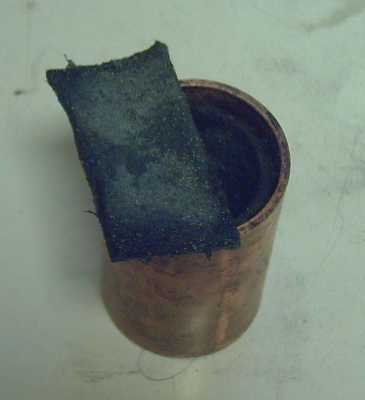 [17th] I put
some graphite felt around the inside rim of the large ("~C cell") can
made last month and started plating it with zinc chloride and a zinc
anode. After a while it occurred to me I hadn't weighed the can, so I
pulled it apart again. 48.75 grams - far more copper than a C cell
shell required! The copper didn't seem to have much zinc on it, but
felt pieces had some dark lines at the joins, and it seemed to me
the felt had to be very lightly ripped away from the copper to remove
it - bonding/plating. Good. While I was at it, weighing a small piece
of the felt
indicated that the felt in the cell should have been about .5 to .6
grams when first put in. I weighed it and got 2.8 grams. Trouble was it
was wet, so some of the extra was water and not zinc plating. I wasn't
willing to wait for it to dry out. (I supposed I could have pretty much
blotted it dry with a paper towel?) It had a sort of crunchy texture
instead of being soft and what looked like grayish zinc was visible, so
it seemed it must have some plating.
[17th] I put
some graphite felt around the inside rim of the large ("~C cell") can
made last month and started plating it with zinc chloride and a zinc
anode. After a while it occurred to me I hadn't weighed the can, so I
pulled it apart again. 48.75 grams - far more copper than a C cell
shell required! The copper didn't seem to have much zinc on it, but
felt pieces had some dark lines at the joins, and it seemed to me
the felt had to be very lightly ripped away from the copper to remove
it - bonding/plating. Good. While I was at it, weighing a small piece
of the felt
indicated that the felt in the cell should have been about .5 to .6
grams when first put in. I weighed it and got 2.8 grams. Trouble was it
was wet, so some of the extra was water and not zinc plating. I wasn't
willing to wait for it to dry out. (I supposed I could have pretty much
blotted it dry with a paper towel?) It had a sort of crunchy texture
instead of being soft and what looked like grayish zinc was visible, so
it seemed it must have some plating.
 I
cleaned the inside of the can with scotchbrite and then sandpaper
hoping to get better zinc plating to the can itself. Then I put it back
together and back onto charge. More than once I pulled out the anode
and rubbed it around to end a short circuit. (Sigh, zinc dendrites!)
After a few hours I took
it off and rubbed off the loosest particles. It weighed 53.05 grams
(dry), indicating well over 3 grams of zinc plated into the graphite
felt and onto the copper. About 3 amp-hours worth if it all works. Not
very shiny but a nice, thick coat!
I
cleaned the inside of the can with scotchbrite and then sandpaper
hoping to get better zinc plating to the can itself. Then I put it back
together and back onto charge. More than once I pulled out the anode
and rubbed it around to end a short circuit. (Sigh, zinc dendrites!)
After a few hours I took
it off and rubbed off the loosest particles. It weighed 53.05 grams
(dry), indicating well over 3 grams of zinc plated into the graphite
felt and onto the copper. About 3 amp-hours worth if it all works. Not
very shiny but a nice, thick coat!
Then I got onto other things and didn't get back to this. Sigh! When
I've made a plastic bottom and cap for this size it'll be about ready
to assemble.
https://www.TurquoiseEnergy.com
https://TurquoiseEnergy.neocities.com
Haida Gwaii, BC Canada


 I
put some conductive graphite felt around the inside rim of the larger
"C" cell
and got about 3 grams of zinc plated into it, and surely enough onto
the cleaned copper can to make a solid zinc trail to conduct from the
felt to the copper can. So the cell is almost ready to assemble. I was
surprised how much the remaining diameter is reduced.
I
put some conductive graphite felt around the inside rim of the larger
"C" cell
and got about 3 grams of zinc plated into it, and surely enough onto
the cleaned copper can to make a solid zinc trail to conduct from the
felt to the copper can. So the cell is almost ready to assemble. I was
surprised how much the remaining diameter is reduced.


 Then I started thinking about all the little things it needed if it was
to become a "nice" project car. What about the cracked windshield? And
the broken tail light? And the non-functional parking brake (ever since
I changed rear brake shoes)? And then how about that intermittent and
noisy cab air fan? And the dash lights that only work sometimes? And
the much pitted, fogged-up plastic headlights? It could use some
cleanup and a vacuuming, too! With 420 Mm* on it, it could hardly be
expected to be like new. I dealt with a few of these things, and they
occupied several days of the month.
Then I started thinking about all the little things it needed if it was
to become a "nice" project car. What about the cracked windshield? And
the broken tail light? And the non-functional parking brake (ever since
I changed rear brake shoes)? And then how about that intermittent and
noisy cab air fan? And the dash lights that only work sometimes? And
the much pitted, fogged-up plastic headlights? It could use some
cleanup and a vacuuming, too! With 420 Mm* on it, it could hardly be
expected to be like new. I dealt with a few of these things, and they
occupied several days of the month.


 The
International Energy Association has said that solar PV is now the
cheapest energy the world has ever seen, and that we are moving into an
era of "insanely cheap" energy. And that's even without HE ray "free
energy"!
The
International Energy Association has said that solar PV is now the
cheapest energy the world has ever seen, and that we are moving into an
era of "insanely cheap" energy. And that's even without HE ray "free
energy"!
 Ganymede has
a magnetic field rather similar
to Earth's. Lately astronomers have used one o' them fancy new
telescopes to image its auroral displays. (Well, I can't remember the
details.)
Ganymede has
a magnetic field rather similar
to Earth's. Lately astronomers have used one o' them fancy new
telescopes to image its auroral displays. (Well, I can't remember the
details.) Even so, both heart disease and cancer each killed almost
twice as many people as were previously reported to have died of the
virus. Yet there is no big push being made to eliminate these "more
epidemic" causes of death. Society isn't being disrupted and shut down
- not even the "worst culprit" foods and drinks are being pointed out.
No one is being lectured about healthier diets or the need to
take vitamin D to be resistant to cancer if you're not getting out in
the sunshine.
Even so, both heart disease and cancer each killed almost
twice as many people as were previously reported to have died of the
virus. Yet there is no big push being made to eliminate these "more
epidemic" causes of death. Society isn't being disrupted and shut down
- not even the "worst culprit" foods and drinks are being pointed out.
No one is being lectured about healthier diets or the need to
take vitamin D to be resistant to cancer if you're not getting out in
the sunshine. But I found that the LiPOs that were already in the truck
were horribly swollen up! Had they been badly overcharged too? Frozen?
(In the garage?!?) To my shock they all read 0.0 volts! The other
possibility then was
that they had been totally discharged. (They swell up if they're
discharged?) I had left them fully charged in the truck, but assuming
there was no load on them if the truck was shut off, I hadn't looked at
it for months. It had no clock, no radio, and the contactor solenoid
shut
off the motor controller when the key was off -- what on Earth would
draw current if it was shut off? Apparently there must be
something. Sh*t! That doubtless explained the deteriorations and
pretty much demise of the lead-acids over time, too. In all the time
I've had the truck I never suspected that they were always under load -
however light - rather than being idle. Why didn't I think of it? So
many newer vehicles (well, since around ?1985) draw current and drain
the battery even while they're sitting. But how much does it draw,
anyway, that it would drain several kilowatt-hours, even over a few
months? [calculating...] Well it would have to be well over a watt
rather than milliwatts. Obviously
I should have disconnected the batteries entirely when I put the truck
away. For the future I'll put a 500 amp fuse at the 36 volt point, that
I can disconnect if I'm not going to be using the truck. (By putting it
at the middle point, even if the system should become grounded
somewhere that's okay to touch.)
But I found that the LiPOs that were already in the truck
were horribly swollen up! Had they been badly overcharged too? Frozen?
(In the garage?!?) To my shock they all read 0.0 volts! The other
possibility then was
that they had been totally discharged. (They swell up if they're
discharged?) I had left them fully charged in the truck, but assuming
there was no load on them if the truck was shut off, I hadn't looked at
it for months. It had no clock, no radio, and the contactor solenoid
shut
off the motor controller when the key was off -- what on Earth would
draw current if it was shut off? Apparently there must be
something. Sh*t! That doubtless explained the deteriorations and
pretty much demise of the lead-acids over time, too. In all the time
I've had the truck I never suspected that they were always under load -
however light - rather than being idle. Why didn't I think of it? So
many newer vehicles (well, since around ?1985) draw current and drain
the battery even while they're sitting. But how much does it draw,
anyway, that it would drain several kilowatt-hours, even over a few
months? [calculating...] Well it would have to be well over a watt
rather than milliwatts. Obviously
I should have disconnected the batteries entirely when I put the truck
away. For the future I'll put a 500 amp fuse at the 36 volt point, that
I can disconnect if I'm not going to be using the truck. (By putting it
at the middle point, even if the system should become grounded
somewhere that's okay to touch.)




 With the tall stack of LiIon's too likely to fall over, I made
a couple of aluminum brackets, drilled some holes, and bolted it into
place.
This time I moved "the place" over toward the middle so I could get a
screwdriver in behind to undo the screws and connect meters on the dash
to show
battery voltages.
With the tall stack of LiIon's too likely to fall over, I made
a couple of aluminum brackets, drilled some holes, and bolted it into
place.
This time I moved "the place" over toward the middle so I could get a
screwdriver in behind to undo the screws and connect meters on the dash
to show
battery voltages.


 I
dug out the 120 tooth, #40 chain sprocket that I had
made to fit on a car wheel, and I pulled out a 20 tooth one (from 2016
experiments) that would give it 6 to 1 reduction. By having a gear
almost as large as the wheel (hopefully I didn't go TOO large - there's
not much ground clearance if the tire is low), the forces on the chain
are reduced. With a smaller gear a #50 or #60 chain might be a better
choice. I expect #40 chain, wrapping around larger sprockets, will have
lower losses and last longer.
I
dug out the 120 tooth, #40 chain sprocket that I had
made to fit on a car wheel, and I pulled out a 20 tooth one (from 2016
experiments) that would give it 6 to 1 reduction. By having a gear
almost as large as the wheel (hopefully I didn't go TOO large - there's
not much ground clearance if the tire is low), the forces on the chain
are reduced. With a smaller gear a #50 or #60 chain might be a better
choice. I expect #40 chain, wrapping around larger sprockets, will have
lower losses and last longer. [19th] I got
around to cutting out a 3/16" steel plate as the base for
the powered side of the saw. I had made marking on the wood, now used
those to size up the steel. I drilled the bolt holes and tried it out.
After a couple of small cuts to trim it, it seemed about right. I have
the idea to mount the guide wheel assembly on the end stops, so it
won't need a separate (third) post.
[19th] I got
around to cutting out a 3/16" steel plate as the base for
the powered side of the saw. I had made marking on the wood, now used
those to size up the steel. I drilled the bolt holes and tried it out.
After a couple of small cuts to trim it, it seemed about right. I have
the idea to mount the guide wheel assembly on the end stops, so it
won't need a separate (third) post. [21st] I welded on two 8
inch posts of 3/4 inch square steel tubing to
this base for mounting the depth setting bars, the left end stop/guide
and the left side band guide wheel assembly. Then, having all the
equipment out on the lawn, I made a mirror image copy for the right
end. The plate is actually identical - just turn it over.
[21st] I welded on two 8
inch posts of 3/4 inch square steel tubing to
this base for mounting the depth setting bars, the left end stop/guide
and the left side band guide wheel assembly. Then, having all the
equipment out on the lawn, I made a mirror image copy for the right
end. The plate is actually identical - just turn it over. I put it
together on the "backbone" rails. It looked
pretty good. Of course for production I will draw out the plates in a
CAD program and
then send them off to be CNC waterjet cut. (...unless I get my own
plasma cutter working on the CNC platform. Well, not this month.)
I put it
together on the "backbone" rails. It looked
pretty good. Of course for production I will draw out the plates in a
CAD program and
then send them off to be CNC waterjet cut. (...unless I get my own
plasma cutter working on the CNC platform. Well, not this month.) [17th] I put
some graphite felt around the inside rim of the large ("~C cell") can
made last month and started plating it with zinc chloride and a zinc
anode. After a while it occurred to me I hadn't weighed the can, so I
pulled it apart again. 48.75 grams - far more copper than a C cell
shell required! The copper didn't seem to have much zinc on it, but
felt pieces had some dark lines at the joins, and it seemed to me
the felt had to be very lightly ripped away from the copper to remove
it - bonding/plating. Good. While I was at it, weighing a small piece
of the felt
indicated that the felt in the cell should have been about .5 to .6
grams when first put in. I weighed it and got 2.8 grams. Trouble was it
was wet, so some of the extra was water and not zinc plating. I wasn't
willing to wait for it to dry out. (I supposed I could have pretty much
blotted it dry with a paper towel?) It had a sort of crunchy texture
instead of being soft and what looked like grayish zinc was visible, so
it seemed it must have some plating.
[17th] I put
some graphite felt around the inside rim of the large ("~C cell") can
made last month and started plating it with zinc chloride and a zinc
anode. After a while it occurred to me I hadn't weighed the can, so I
pulled it apart again. 48.75 grams - far more copper than a C cell
shell required! The copper didn't seem to have much zinc on it, but
felt pieces had some dark lines at the joins, and it seemed to me
the felt had to be very lightly ripped away from the copper to remove
it - bonding/plating. Good. While I was at it, weighing a small piece
of the felt
indicated that the felt in the cell should have been about .5 to .6
grams when first put in. I weighed it and got 2.8 grams. Trouble was it
was wet, so some of the extra was water and not zinc plating. I wasn't
willing to wait for it to dry out. (I supposed I could have pretty much
blotted it dry with a paper towel?) It had a sort of crunchy texture
instead of being soft and what looked like grayish zinc was visible, so
it seemed it must have some plating. I
cleaned the inside of the can with scotchbrite and then sandpaper
hoping to get better zinc plating to the can itself. Then I put it back
together and back onto charge. More than once I pulled out the anode
and rubbed it around to end a short circuit. (Sigh, zinc dendrites!)
After a few hours I took
it off and rubbed off the loosest particles. It weighed 53.05 grams
(dry), indicating well over 3 grams of zinc plated into the graphite
felt and onto the copper. About 3 amp-hours worth if it all works. Not
very shiny but a nice, thick coat!
I
cleaned the inside of the can with scotchbrite and then sandpaper
hoping to get better zinc plating to the can itself. Then I put it back
together and back onto charge. More than once I pulled out the anode
and rubbed it around to end a short circuit. (Sigh, zinc dendrites!)
After a few hours I took
it off and rubbed off the loosest particles. It weighed 53.05 grams
(dry), indicating well over 3 grams of zinc plated into the graphite
felt and onto the copper. About 3 amp-hours worth if it all works. Not
very shiny but a nice, thick coat!